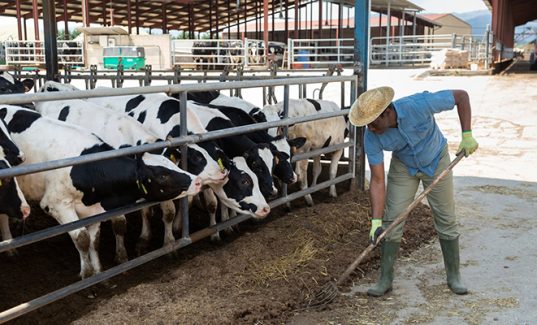Dairy farmers are striving to keep improving herd genetics, despite their current price woes.
The past two seasons of dry conditions then slashed farmgate milk prices have left Australian dairy farms with plenty of financial catch-up to do.
But some genetics companies are reporting this hasn’t diminished solid demand for their bulls.
 DataGene genetic evaluation manager Michelle Axford said farmers were still buying good bulls, but now wanted to pay a little less
DataGene genetic evaluation manager Michelle Axford said farmers were still buying good bulls, but now wanted to pay a little less
“Our analysis shows the price of bulls and their genetic merit — farmers do not necessarily have to pay more to get a high balanced performance index,” she said.
Ms Axford said it was common for dairy farmers to buy semen for their better-performing cows and use their own bulls, or a beef bull, for the remainder of the herd.
“They can take the poorest cows and breed them for beef and do not keep the calf, then there’s overall improvement in the genetics,” she said.
“But it only works if they have enough replacements.”
Ms Axford said genetics companies had also experienced a good year for sexed semen.
“I’m surprised at how sexed semen is faring and it’s great for improving herds,” she said.
Genetics Australia general manager Anthony Shelly said he did not believe price was the dominant factor in dairy farmers’ genetics choices.
“Most farmers are looking to improve their genetic base,” he said.
“They are searching for overall quality and improvement.”
Mr Shelly said there was demand for overall balanced performance index, with a focus on fertility.
“Previously we might have seen farmers only AI for their top cows, but today they’re working across the whole herd.”
Coomboona Holsteins breeder Alex Arena said dairy farmers needed to be focused on output.
“Sure dairy farming is a lifestyle, but it is a business,” Mr Arena said. “Everyone has to be focused on output.”
He said costs could be managed through productivity improvements.
“Cows which are very efficient producers of milk reduce the cost per litre,” Mr Arena said.
“Or people can choose a bull to increase butterfat or protein or improve health status.
“They might want easier calving so they get more live calves.”
He said rather than looking at whether a bull was $20 a straw or $5 a straw, farmers should look at how much revenue the bull could bring in.
“The need to ask, does this bull make my job better than that bull?” Mr Arena said.
.ABS Australia national sales manager Paul Quinlan said there was demand through Victoria and Tasmania for a moderate-sized cow.
“We’re finding our lesser statured bulls are the ones in demand, but in NSW and Queensland they prefer the taller cattle,” Mr Quinlan said.
“People still want the specific traits such as daughter fertility and lower cell count.”
Mr Quinlan said there was some evidence that smaller cows were more efficient.
He said despite a tough couple of seasons ABS’s top bulls were still its best sellers.
“The best bulls are always in demand,” Mr Quinlan said.
“But for the massive bulls in the mid-rankings, people might also be looking for a mix of good udders and good fertility.
“Everyone wants more profitable cows.”
Meanwhile Ms Axford said there was little movement in the bull rankings this release.
“Sometimes hot new bulls move on the lists, but not this time,” she said.
“We’re seeing a lot of stability in the proofs between April and August. “
Ms Axford said there were some familiar names on the genomic list.
Mr Shelly said he could see a strong level of stability in the overall breed values.
“Often we will see variations, which is not always a bad thing, but is sometimes frustrating,” he said.
“A number of the older bulls are still performing well with big numbers of daughters.
“For farmers looking for a greater level of confidence, those ones are the reliable ones.”
Source: Farmers Weekly




